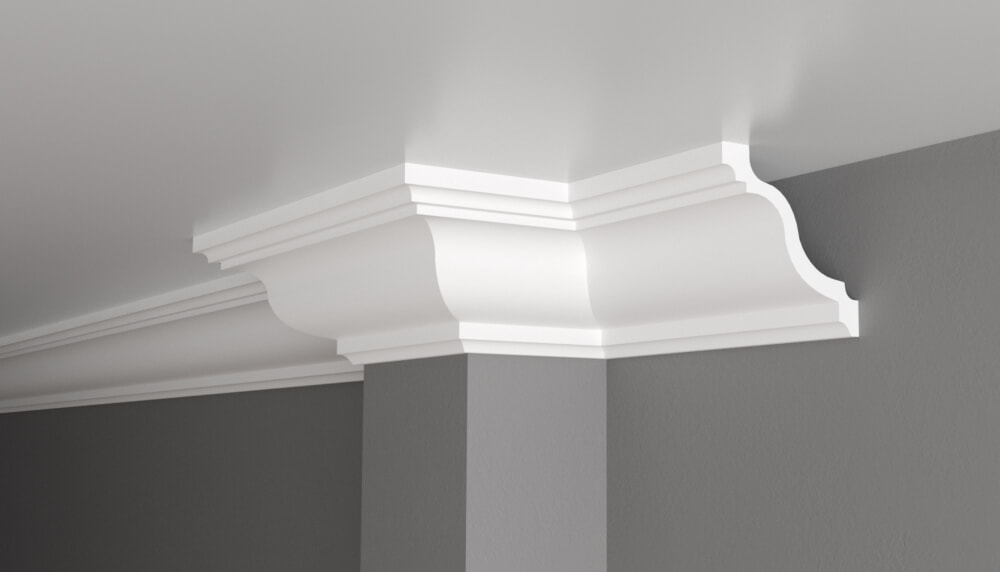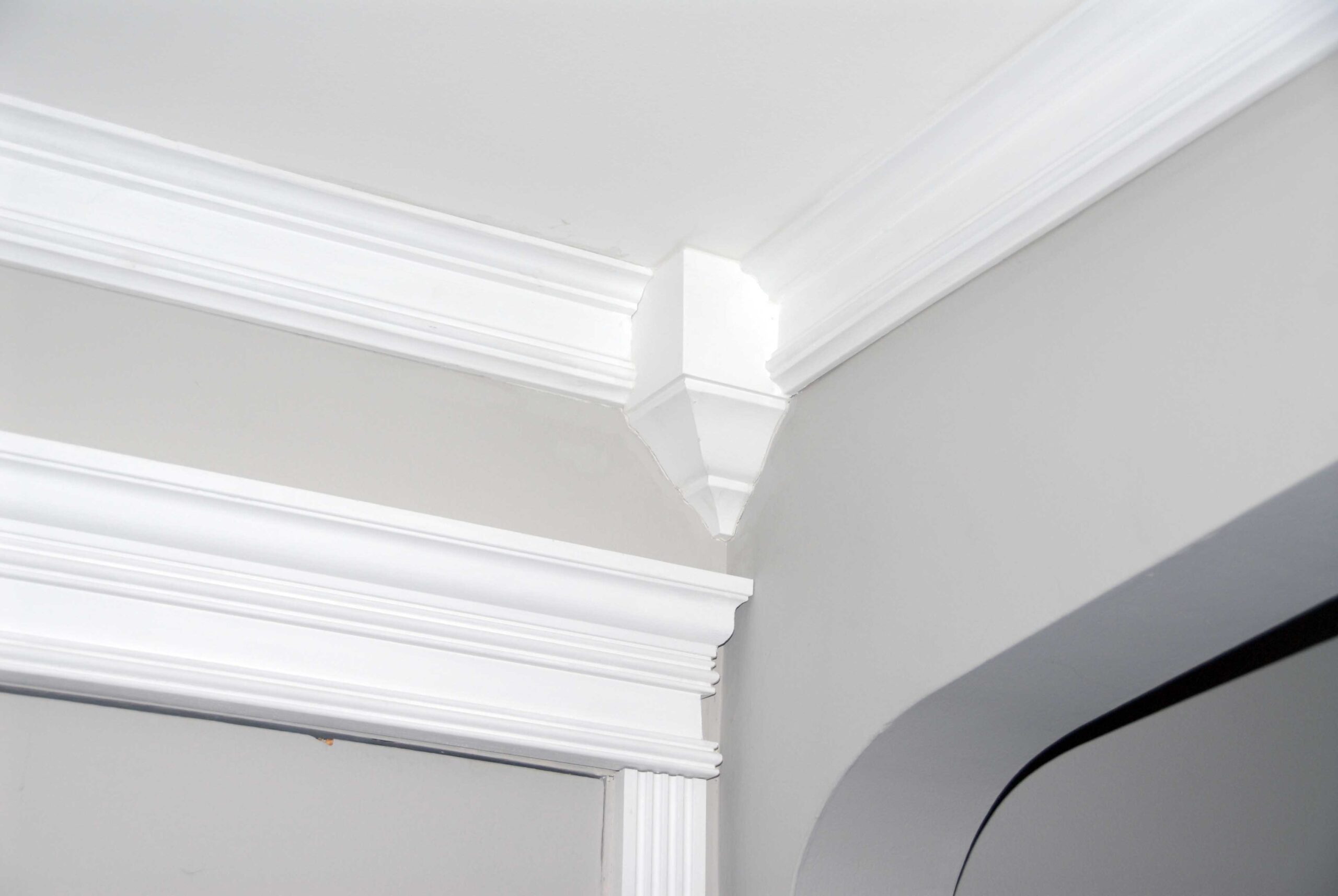Crown molding is a classic architectural element that brings character and refinement to any room. This decorative trim, installed where walls meet the ceiling, can transform a plain space into one with sophisticated elegance. At Radford Woodworks, we’ve witnessed countless homes undergo remarkable changes with the addition of crown molding.
Crown molding serves both aesthetic and practical purposes. It creates a smooth transition between walls and ceilings, effectively hiding any imperfections in these joints. This simple addition can make rooms appear larger and more polished, giving them a finished look that’s hard to achieve with paint alone.
The Benefits of Crown Molding
Many homeowners appreciate crown molding for its ability to enhance their living spaces in multiple ways. One of the primary advantages is its visual appeal. Crown molding draws the eye upward, creating an illusion of height and spaciousness. This vertical emphasis can make even smaller rooms feel more open and airy. In larger spaces, it adds a touch of grandeur that can turn an ordinary room into a showstopper.
Another significant benefit of crown molding is its ability to hide imperfections. Over time, homes can develop small cracks or unevenness where walls meet ceilings. These flaws can be particularly noticeable in older homes or those that have settled over the years. Crown molding effectively covers these imperfections, presenting a clean, seamless appearance that can rejuvenate a room without the need for extensive repairs.
From a practical standpoint, crown molding can increase a home’s market value. Well-installed crown molding is often seen as a desirable feature by potential buyers. It’s a detail that suggests quality construction and attention to detail, which can set a home apart in a competitive real estate market.
The versatility of crown molding in design is another factor that makes it so appealing. It comes in a wide array of styles, from simple and modern to ornate and traditional. This variety allows homeowners to find a style that perfectly complements their interior design theme, whether it’s a sleek contemporary look or a more classical aesthetic.
Types of Crown Molding
Crown molding isn’t a one-size-fits-all solution. Different styles suit different architectural designs and personal preferences. Understanding the various types can help homeowners make informed decisions about what will work best in their spaces.
Traditional Crown Molding
This style features curves and sometimes ornate patterns. It’s ideal for formal spaces or homes with classical architecture. Traditional crown molding often includes details like egg-and-dart patterns, dentil molding, or acanthus leaf designs. These intricate details can add a touch of luxury and sophistication to living rooms, dining rooms, or master bedrooms.
Modern Crown Molding
Characterized by clean lines and minimal ornamentation, modern crown molding suits contemporary interiors. This style often features simple, geometric shapes that create a crisp, clean look. Modern crown molding can be an excellent choice for homes with a minimalist aesthetic or for those looking to add a subtle architectural detail without overwhelming the space.
Craftsman-Style Crown Molding
With its sturdy appearance and simple design, this style complements homes with a more rustic or handcrafted aesthetic. Craftsman-style crown molding often features straight lines and minimal embellishment, focusing on the natural beauty of the wood grain. This type of molding works well in bungalows, Arts and Crafts-style homes, or any space aiming for a warm, organic feel.
Coved Crown Molding
This type has a concave profile, softening the transition between wall and ceiling. It’s great for creating a subtle, elegant look. Coved crown molding can be particularly effective in rooms with lower ceilings, as it creates a gentle curve that can make the space feel more open.
Art Deco Crown Molding
Bold geometric patterns define this style, perfect for making a statement in rooms with dramatic decor. Art Deco crown molding often features stepped designs, sunburst patterns, or stylized floral motifs. This type of molding can be a striking addition to homes looking to capture the glamour and sophistication of the 1920s and 1930s.
Flexible Crown Molding
Made from materials like polyurethane, this type can be bent to fit curved walls or irregular angles. Flexible crown molding is an excellent solution for homes with unique architectural features or for creating custom designs that go beyond straight lines.
Choosing the Right Crown Molding
Selecting the appropriate crown molding involves considering several factors to ensure the best fit for your home. The size of the room and the height of the ceiling play a crucial role in this decision. Larger rooms with high ceilings can handle more substantial molding, creating a dramatic effect that suits the scale of the space. In contrast, smaller rooms or those with lower ceilings benefit from simpler, less imposing styles that add detail without overwhelming the area.
The existing decor of your home should also guide your choice of crown molding. Your selection should complement your home’s current style to create a cohesive look. For instance, a Victorian-style home might call for more ornate molding with intricate details and curves. On the other hand, a minimalist space would be better suited to sleeker designs with clean lines and subtle profiles.
Material choice is another important consideration when selecting crown molding. Crown molding comes in various materials, each with its own set of benefits. Wood is a classic choice, offering a warm, natural look and the ability to be stained or painted. Plaster molding can be cast into intricate designs and is often used in historical restorations. Polyurethane and medium-density fiberboard (MDF) offer more affordable options that are lightweight and resistant to warping or cracking.
The color and finish of your crown molding can significantly impact its overall effect in a room. Crown molding can be painted to match or contrast with your walls and ceiling, depending on the look you’re aiming to achieve. A matching color can create a seamless, cohesive appearance, while a contrasting color can make the molding stand out as a feature element. The finish can also vary from matte to high gloss, allowing you to further customize the look to suit your preferences and the room’s lighting conditions.
Installation Considerations
While some homeowners might consider crown molding installation a DIY project, professional installation often yields the best results. Proper installation requires a combination of skills and tools to ensure a flawless finish.
Precise measurements are crucial for a seamless fit, especially in corners and along uneven walls. Even small discrepancies can result in gaps or misalignments that detract from the overall look. Professional installers have the experience to account for these variations and make the necessary adjustments.
Skilled cutting is another critical aspect of crown molding installation. Crown molding must be cut at specific angles to fit properly, requiring specialized tools and knowledge. This is particularly important for inside and outside corners, where precise miter cuts are essential for a tight, seamless join.
The method of attaching crown molding can vary depending on the material of the molding and the type of wall. Different materials and wall types require different attachment methods to ensure the molding stays securely in place over time. Professional installers are familiar with these variations and can choose the most appropriate method for each situation.
After installation, finishing touches like caulking and painting are often necessary to achieve a polished look. These final steps can make the difference between a good installation and a great one, hiding any small imperfections and creating a truly seamless appearance.
Creative Uses of Crown Molding
Beyond its traditional application at the junction of walls and ceilings, crown molding can be used creatively to enhance various areas of your home. One popular application is framing doorways and windows. Adding crown molding to these openings can create a more formal, finished look that draws attention to these architectural features.
Crown molding can also be used to accent built-in shelving, giving bookcases or cabinets a custom, high-end appearance. This application can turn simple storage solutions into striking focal points within a room.
For large wall spaces, crown molding can be used to create decorative wall panels. This technique adds depth and interest to otherwise plain walls, creating a sense of architectural detail where none existed before.
In rooms with fireplaces, crown molding can be used to enhance the mantel, making it more prominent and stylish. This can help to emphasize the fireplace as a central feature of the room.
For homes with tray ceilings, crown molding can be used to accentuate this architectural feature. By outlining the recessed area of the ceiling, the molding draws the eye upward and highlights the unique ceiling design.
Trends in Crown Molding
As with all aspects of home design, crown molding trends evolve over time. Currently, we’re seeing a move towards mixed materials in crown molding design. Combining different materials, like wood and metal, can create a unique, contemporary look that adds visual interest to a space.
Color is another area where trends are shifting. Moving beyond traditional white, homeowners are experimenting with painted molding in rich, saturated hues. This can create a bold, dramatic effect that turns the crown molding into a standout feature of the room.
In spaces that can accommodate it, oversized moldings are making a statement. Larger, more dramatic profiles can create a luxurious, high-end feel in spacious rooms with tall ceilings.
Layered moldings are also gaining popularity. Using multiple pieces of molding together creates depth and visual interest, allowing for more complex and customized designs.
For environmentally conscious homeowners, eco-friendly options are becoming increasingly available. Sustainable materials and production methods are being used to create crown molding that’s both beautiful and environmentally responsible.
Maintaining Your Crown Molding
To keep your crown molding looking its best over the years, regular maintenance is key. Dust and clean the molding regularly to prevent dirt buildup, which can dull its appearance over time. Use a soft cloth or duster to avoid scratching the surface.
If your molding is painted, you may need to touch up chips or scratches periodically. Keeping some extra paint on hand can make these touch-ups quick and easy. For stained wood molding, a furniture polish or wood conditioner can help maintain its luster.
It’s also important to periodically inspect your crown molding for any signs of separation from the wall or ceiling. Addressing these issues quickly can prevent further damage and maintain the molding’s seamless appearance.
The Impact on Home Value

Well-executed crown molding can have a positive impact on your home’s value. It’s often seen as a sign of quality construction and attention to detail. When considering selling your home, crown molding can be a feature that sets your property apart in a competitive market.
Real estate professionals often highlight crown molding as a desirable feature in home listings. It’s a detail that can make a lasting impression during home viewings, suggesting a level of sophistication and care in the home’s overall design and maintenance.
Crown molding does more than just beautify a room; it adds architectural interest, hides imperfections, and can even make spaces feel larger. Whether you’re renovating an older home or adding finishing touches to a new build, crown molding is a relatively simple addition that can have a significant impact on your home’s overall aesthetic.
At Radford Woodworks, we understand the transformative power of well-crafted and properly installed crown molding. Our team has the skills and experience to help you choose the right style and execute flawless installation. We work closely with each client to ensure the final result aligns perfectly with their vision and complements their home’s unique character.
Ready to enhance your home with beautiful crown molding? Contact Radford Woodworks at (317) 739-8555 or visit our website at https://radfordwoodworks.com/contact/ to schedule a consultation. Let’s work together to bring a touch of elegance to your living spaces.






